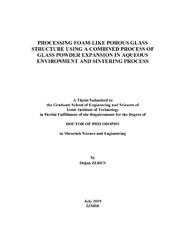Please use this identifier to cite or link to this item:
https://hdl.handle.net/11147/7439Full metadata record
| DC Field | Value | Language |
|---|---|---|
| dc.contributor.advisor | Güden, Mustafa | |
| dc.contributor.advisor | Akdoğan, Yaşar | |
| dc.contributor.author | Zeren, Doğuş | - |
| dc.date.accessioned | 2019-12-09T07:06:46Z | |
| dc.date.available | 2019-12-09T07:06:46Z | |
| dc.date.issued | 2019-07 | en_US |
| dc.identifier.citation | Zeren, D. (2019). Processing foam-like porous glass structure using a combined process of glass powder expansion in aqueous environment and sintering process. Unpublished doctoral dissertation, Izmir Institute of Technology, Izmir, Turkey | en_US |
| dc.identifier.uri | https://hdl.handle.net/11147/7439 | |
| dc.description | Thesis (Doctoral)--Izmir Institute of Technology, Materials Science and Engineering, Izmir, 2019 | en_US |
| dc.description | Includes bibliographical references (leaves: 98-104) | en_US |
| dc.description | Text in English; Abstract: Turkish and English | en_US |
| dc.description.abstract | Soda-lime glass foams were formed by the controlled pore structure of inorganic particle-liquid suspensions at room temperature and then sintered at elevated temperatures between 650oC-800 oC. The slurries were prepared using the glass particles below 38 µm (fine), between 38 and 45 µm (medium) and between 45 and 56 µm (coarse) and with 50, 55, and 60 wt% solid content and 2, 3, and 4 wt% carboxymethyl cellulose (CMC) binder addition. The slurries were foamed using an Al-based foaming agent and a calcium hydroxide alkali activator with an amount of 1 wt%. An increase in CMC content and a decrease in particle size shifted the slurries from a Newtonian to a non-Newtonian behavior and slurry stabilization with the CMC addition. The extensively increased initial bubble pressure in high viscosity slurries resulted in higher linear expansion rate initially followed by a bursting of gas bubbles. The maximum foam linear expansion of the slurries increased with CMC addition until about ~5 Pa s and the expansions stayed almost constant over 400% expansion, while the slurries with the viscosity above 50 Pa s could not be foamed. The most effective factor on the maximum expansion was found the solid content followed by CMC content and the least effective factor was determined the particle size. Partial bonding of glass particles and excessive shrinkage of glass particles due to the melting of foam green bodies were seen at 650 and 800 oC sintering temperatures. Prepared foam glasses showed lower compressive strengths and thermal conductivities than the glass foams reported in the literature. Finally, foaming at room temperature with this technique was found to be more advantageous than conventional glass foam production techniques due to ease of pore formation controlling at room temperature. | en_US |
| dc.description.abstract | Soda-kireç cam köpükleri, oda sıcaklığında inorganik tanecik-sıvı süspansiyonlarının kontrollü gözenek yapısı ile oluşturulmuştur ve daha sonra 650-800 oC arasında yüksek sıcaklıklarda sinterlenmiştir. Bulamaçlar, 38 µm (ince) altı, 38 ve 45 µm arası (orta), ve 45 ve 56 µm arası (kaba) cam partiküller kullanılarak ağırlıkça %50, %55 ve %60 katı oranlarıyla ve ağırlıkça %2, %3 ve %4 CMC bağlayıcı ilavesiyle hazırlanmıştır. Bulamaçlar, ağırlıkça %1 miktarında Al bazlı bir köpürtme ajanı ve ağırlıkça %1 miktarında bir kalsiyum hidroksit alkali aktivatörü kullanılarak köpükleştirilmiştir. CMC içeriğindeki artış ve tane boyutundaki düşüş, bulamaçları Newtonian ’dan Newtonian olmayan bir davranışa götürmüştür ve CMC ile bulamaçlar stabilize edilmiştir. Yüksek viskoziteli bulamaçlardaki yoğun şekilde artan başlangıç kabarcık basıncı, daha sonra gaz kabarcığı patlamasıyla daha yüksek doğrusal genleşme oranına sebep olmuştur. Bulamaçların maksimum köpük lineer genleşmesi, CMC ilavesi ile yaklaşık ~ 5 Pa s'ye kadar artmıştır ve genleşmeler, %400 genişlemenin üzerinde sabit kalırken, 50 Pa s'nın üzerindeki viskoziteye sahip bulamaçlar köpükleşememiştir. Maksimum genleşmedeki en etkili faktör, katı oranının ardından CMC içeriği olarak bulunmuştur ve en az etkili faktörün tane boyutu olduğu tespit edilmiştir. Cam partiküllerin kısmı olarak bağlanması ve yaş köpük malzemenin aşırı büzülmesi 650 ve 800 oC sinterleme sıcaklıklarında görülmüştür. Hazırlanan cam köpükler, literatürde bildirilen cam köpüklerden daha düşük basma dayanımı ve termal iletkenlik göstermiştir. Son olarak, bu teknikle oda sıcaklığında köpükleştirmenin, oda sıcaklığında kontrollü gözenek oluşumu kolaylığından dolayı geleneksel cam köpük üretim tekniklerinden daha avantajlı olduğu bulunmuştur. | en_US |
| dc.format.extent | xv, 120 leaves | en_US |
| dc.language.iso | en | en_US |
| dc.publisher | Izmir Institute of Technology | en_US |
| dc.rights | info:eu-repo/semantics/openAccess | en_US |
| dc.subject | Insulating materials | en_US |
| dc.subject | Soda-lime glasses | en_US |
| dc.subject | Microporous | en_US |
| dc.subject | Ceramic materials | en_US |
| dc.title | Processing foam-like porous glass structure using a combined process of glass powder expansion in aqueous environment and sintering process | en_US |
| dc.title.alternative | Sulu ortamda cam tozunun genleşmesi ve sinterleme yöntemini birlikte kullanarak köpüksü gözenekli cam yapıların öretimi | en_US |
| dc.type | Doctoral Thesis | en_US |
| dc.institutionauthor | Zeren, Doğuş | - |
| dc.department | Thesis (Doctoral)--İzmir Institute of Technology, Materials Science and Engineering | en_US |
| dc.relation.publicationcategory | Tez | en_US |
| item.grantfulltext | open | - |
| item.openairecristype | http://purl.org/coar/resource_type/c_18cf | - |
| item.cerifentitytype | Publications | - |
| item.openairetype | Doctoral Thesis | - |
| item.languageiso639-1 | en | - |
| item.fulltext | With Fulltext | - |
| Appears in Collections: | Phd Degree / Doktora | |
Files in This Item:
| File | Description | Size | Format | |
|---|---|---|---|---|
| T001927.pdf | DoctoralThesis | 20.51 MB | Adobe PDF |  View/Open |
CORE Recommender
Page view(s)
170
checked on Apr 22, 2024
Download(s)
470
checked on Apr 22, 2024
Google ScholarTM
Check
Items in GCRIS Repository are protected by copyright, with all rights reserved, unless otherwise indicated.